Scirtidae
Marsh beetles



This tree diagram shows the relationships between several groups of organisms.
The root of the current tree connects the organisms featured in this tree to their containing group and the rest of the Tree of Life. The basal branching point in the tree represents the ancestor of the other groups in the tree. This ancestor diversified over time into several descendent subgroups, which are represented as internal nodes and terminal taxa to the right.

You can click on the root to travel down the Tree of Life all the way to the root of all Life, and you can click on the names of descendent subgroups to travel up the Tree of Life all the way to individual species.
For more information on ToL tree formatting, please see Interpreting the Tree or Classification. To learn more about phylogenetic trees, please visit our Phylogenetic Biology pages.
close boxIntroduction
Scirtidae is a family comprising about 1400 described species classified in 50 genera. Only three subfamilies are currently recognized: Stenocyphoninae, Nipponocyphoninae, and Scirtinae (Lawrence & Yoshitomi 2007). The family occurs in all zoogeographic regions of the world, although scirtid diversity is greatest in tropics, and in the temperate zone of the Southern Hemisphere.
The vast majority of Scirtidae develop in aquatic habitats, including lakes, streams and rivers, but also in smaller bodies of water, like muddy puddles in forested areas or phytotelmata. Several species from New Zealand, Borneo, and Australia are known however to develop in wet decaying wood or in wet soil (Klausnitzer 2006). Larvae can penetrate deep into ground water, and were once found 10 m below the ground surface (Klausnitzer & Pospisil 1991). Larvae are microphagous, feeding on various microorganisms collected from the surface of decaying plant material and other substrates. Particles of food are sorted on a highly complex filtering apparatus present on the hypopharynx. Pupation usually takes place in wet soil above water surface, rarely also in air-filled cavities under submerged rocks. Adults are generally short lived and are often observed feeding on flowers of various families of plants. Pollinophagy is common within the family.

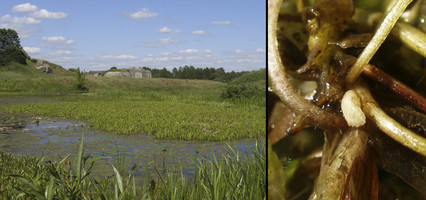
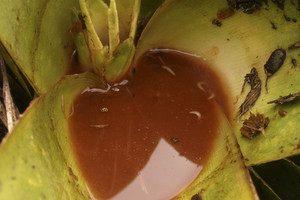
Left: Typical habitat of Scirtes. Center: Scirtes pupa attached to the underside of Hydrocharis morsus-ranae. Right: Scirtes larvae in phytotelm of Pandanaceae. Images © Rafal Ruta
Characteristics
Scirtidae are relatively soft-bodied, ranging from 1.0 to 15.0 mm in length, slightly flattened to very convex, almost subglobular. The body is usually yellowish-brown or brownish to blackish. Several taxa have contrasting patterns consisting of yellow or red spots on black elytra, and others have a metallic hue. The body is usually covered with semierect hairs, but rarely (Macrohelodes) the dorsum is devoid of setation.
Larvae of Scirtidae are very peculiar and can be easily recognized (it should be noted, that larvae of primitive subfamilies Nipponocyphoninae and Stenocyphoninae are unknown) thanks to the following characters:
- antennae multisegmented, and often very long, sometimes exceeding half the body length,
- body strongly sclerotized both in ventral and dorsal part,
- mandibles, maxillae, hypopharynx and epipharynx forming a complex filtering apparatus.

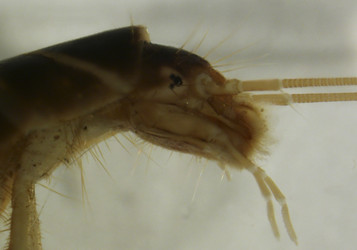
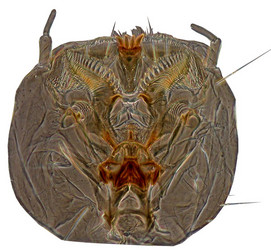
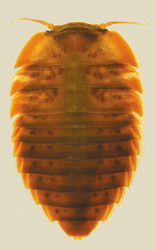
Left: Lateral view of the head of the larva of Pseudomicrocara sp. Center: Ventral view of the hypopharynx of the larva of Prionocyphon serricornis (Mueller). Right: Dorsal view of the larva of Odeles marginata (Fabricius). Images © Rafal Ruta
It is quite difficult to provide a set of features characterizing Scirtidae in the present sense (including Nipponocyphoninae and Stenocyphoninae). The most important characters are (compilation of Lawrence 2001, Lawrence & Yoshitomi 2007, and own data):
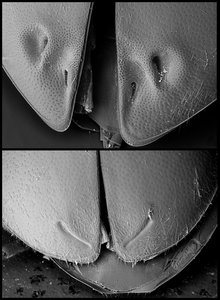
Excitators on the elytral apices of an Oriental Scirtes species. Image © Rafal Ruta
- strongly declined head,
- sharp subgenal ridges,
- small prothorax,
- reduced prosternum (with the exception of Nipponocyphon),
- projecting procoxae,
- broadly open mesocoxal cavities,
- free 3rd ventrite (with the exception of Amplectopus),
- hind wing with a large, triangular radial cell, large anal lobe and reduced venation in the medial field;
- AA3+4 confluent with the anal fold (like in Decliniidae).
An interesting feature of many Scirtidae is the presence of excitators in females. Excitator is a term proposed by the author (Ruta 2008) to designate modifications of females' elytra of secretory function (plausibly secreting pheromones stimulating the male during courtship).
Highly specialised male and female genitalia and copulation in Scirtidae were described by Nyholm (1969, 1972).
Classification
Cyphon padi (L.) was the first described species of Scirtidae. Originally, it was described in the genus Chrysomela (Chrysomelidae). During the 19th century several genera of Scirtidae were classified in a broadly defined Dascillidae, and even in the only existing world catalogue (Pic 1914), part of Scirtidae were treated in the Dascillidae section. Pic (1914) placed some genera in the tribe Dascillini, others in Atopidini of subfamily Dascillinae, and the remaining in the tribe Helodini of subfamily Helodinae. His concept was not based on any formal analysis and was never followed. Another ill-defined concept was the one by Iablokoff-Khnzorian (1961), who studied inclusions of Scirtidae in Baltic amber and proposed two subfamilies (Helodinae and Cyphoninae) with tribes Microcarini, Helodopsini, and Cyphonini.
The first well founded classification was proposed by Lawrence & Yoshitomi (2007). They divided Scirtidae into three subfamilies, two (Nipponocyphoninae & Stenocyphoninae) with one genus each, and a large Scirtinae including the remaining genera.
Relationships of Scirtidae to Other Beetles
Scirtidae are generally believed to be one of the most primitive families of Polyphaga. According to Kukalova-Peck & Lawrence (2004) Scirtidae posses morphological features (i. a. membranous meso- metaventral joint) suggesting that Polyphaga is a sister group to the clade (Archostemata (Myxophaga + Adehaga)). Friedrich & Beutel (2006) published a detailed paper on pterothoracic morphology of Scirtoidea concluding, that features recognized as plesiomorphic are in fact reversals and do not support the Coleoptera branching hypothesis proposed by Kukalova-Peck & Lawrence (2004).Paleontology
Inclusions of Scirtidae are very common in Baltic amber. They constitute 10-20% of all Coleoptera inclusions. Till now, about 20 fossil species were described.
References
Friedrich F., Beutel R.G. 2006. The pterothoracic skeletomuscular system of Scirtoidea (Coleoptera: Polyphaga) and its implications for the high-level phylogeny of beetles. Journal of Zoological Systematics and Evolutionary Research 44, 4: 290-315.
Hannappel U., Paulus H.F. 1987. Arbeiten zu einen phylogenetischen System der Helodidae (Coleoptera) – Feinstrukturuntersuchungen an europäischen Larven. Zoologische Beitrage 31: 77-150.
Hannappel U., Paulus H.F. 1994. 29. Familie: Scirtidae.in Klausnitzer B. (red.). Die Käfer Mitteleuropas. Larven 2. Myxophaga, Polyphaga Teil 1: 74-87. Goecke & Evers Verlag, Krefeld.
Iablokoff-Khnzorian S.M. 1961. Predstawiteli semeystva Helodidae (Coleoptera) iz baltiyskogo yantarya. Paleontologicheskij Zhurnal 1961: 109-116.
Klausnitzer B. 2006. Scirtidae. in: Loebl I., Smetana A. (ed.). Catalogue of Palaearctic Coleoptera, Vol. 3. Stenstrup, Apollo Books: 316-323.
Klausnitzer B. 2009. Insecta: Coleoptera: Scirtidae. Süsswasserfauna von Mitteleuropa 20/17: 1-326.
Klausnitzer B., Pospisil P. 1991. Larvae of Cyphon sp. (Coleoptera, Helodidae) in Ground Water. Aquatic Insects 13, 3: 161-165.
Kukalová-Peck J., Lawrence J.F. 2004. Relationships among coleopteran suborders and major endoneoptera lineages: Evidence from hind wing characters. European Journal of Entomology 101: 95-144.
Lawrence J. F. 2001. A New Genus of Valdivian Scirtidae (Coleoptera) with Comments on Scirtoidea and the Beetle Suborders. Special Publications of the Japan Coleopterological Society Osaka 1: 351-361.
Lawrence J. F. 2005. Scirtidae Fleming, 1821. in Handbook of Zoology, Vol. IV Arthropoda: Insecta. Part 38. Coleoptera, Vol. 1: Morphology and Systematics (Archostemata, Adephaga, Myxophaga, Polyphaga (partim)). Walter De Gruyter, Berlin, New York: 443-450.
Lawrence, J. F. and A. F. Newton. 1995. Families and subfamilies of Coleoptera (with selected genera, notes and references, and data on family-group names). Pages 779-1006 in Biology, Phylogeny, and Classification of Coleoptera: Papers Celebrating the 80th Birthday of Roy A. Crowson. Pakaluk, J. and Slipinski, S. A., eds. Muzeum i Instytut Zoologii PAN, Warsaw.
Lawrence J.F., Yoshitomi H. 2007. Nipponocyphon, a new Genus of Japanese Scirtidae(Coleoptera) and its Phylogenetic Significance. Elytra 35: 507-527.
LeSage, L. 1991. Helodidae (Eucinetoidea) (=Cyphonidae, Scirtidae). Pages 366-369 in Immature Insects. Vol. 2. Stehr, F.W. (ed.) Kendall/Hunt, Dubuque, Iowa. 975 pp.
Nyholm T. 1969. Über Bau und Funktion der Kopulationsorgane bei den Cyphones (Col. Helodidae). Entomologisk Tidskrift 90, 3-4: 233-271.
Nyholm T. 1972b. Zur Morphologie und Funktion des Helodiden-Aedoeagus (Col.). Entomologica scandinavica 3: 81-119.
Pic M. 1914. Dascillidae, Helodidae, Eucinetidae. in: Junk W., Schenkling S., Coleopterorum Catalogus, 10, 58: 1-65.
Ruta R. 2008. Contribution to the knowledge of Seychellois Scirtidae (Coleoptera: Scirtoidea). Zootaxa 1913: 49-68.
Ruta R. 2009. Brachycyphon Fairmaire, 1896, a neglected genus of Afrotropical Scirtidae (Coleoptera). Annales Zoologici 59, 4: 621-628.
Yoshitomi H. 2005. Systematic Revision of the Family Scirtidae of Japan, with phylogeny, morphology and bionomics (Insecta: Coleoptera: Scirtoidea). Japanese Journal of Systematic Entomology, Monographic Series 3: 1-212.
Information on the Internet
- Elateriformia (Coleoptera): Scirtidae.. J. F. Lawrence, A. M. Hastings, M. J. Dallwitz, T. A. Paine and E. J. Zurcher. Delta-intkey.com.
Title Illustrations

| Scientific Name | Nipponocyphon nakanei Lawrence et Yoshitomi, 2007 |
|---|---|
| Specimen Condition | Dead Specimen |
| Sex | Male |
| Copyright |
© Rafal Ruta

|
| Scientific Name | Stenocyphon sasaji Lawrence, 2001 |
|---|---|
| Specimen Condition | Dead Specimen |
| Sex | Female |
| Copyright |
© Rafal Ruta

|
| Scientific Name | Cyphon coarctatus Paykull, 1799 |
|---|---|
| Specimen Condition | Dead Specimen |
| Copyright |
© Rafal Ruta

|
| Scientific Name | Cyphotelus angustifrons Sharp |
|---|---|
| Location | New Zealand |
| Copyright |
© Rafal Ruta

|
| Scientific Name | Sacodes sp. |
|---|---|
| Location | Japan |
| Specimen Condition | Dead Specimen |
| Sex | Female |
| Copyright |
© Rafal Ruta

|
| Scientific Name | Scirtes japonicus Kiesenwetter, 1874 |
|---|---|
| Location | Japan |
| Specimen Condition | Dead Specimen |
| Copyright |
© Rafal Ruta

|
About This Page
Page copyright © 2011
All Rights Reserved.
- First online 15 February 2011
- Content changed 15 February 2011
Citing this page:
Tree of Life Web Project. 2011. Scirtidae. Marsh beetles. Version 15 February 2011 (under construction). http://tolweb.org/Scirtidae/9613/2011.02.15 in The Tree of Life Web Project, http://tolweb.org/




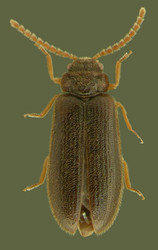
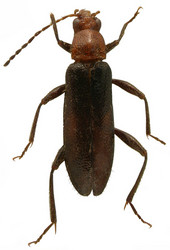
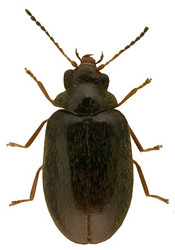
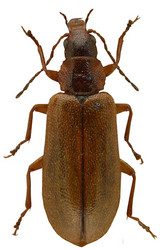
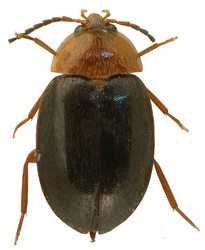
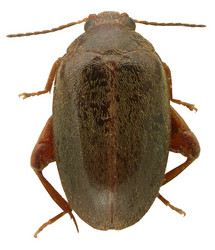







 Go to quick links
Go to quick search
Go to navigation for this section of the ToL site
Go to detailed links for the ToL site
Go to quick links
Go to quick search
Go to navigation for this section of the ToL site
Go to detailed links for the ToL site